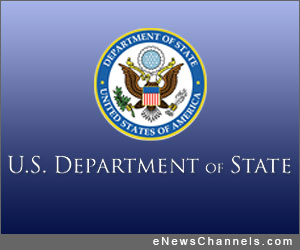 WASHINGTON, D.C. /eNewsChannels/ — Today at the Syria Humanitarian Forum in Geneva, Deputy Assistant Secretary Kelly T. Clements announced that the United States is providing more than $34 million in additional humanitarian assistance to help those affected by the conflict in Syria. With this new assistance, the United States is providing more than $165 million in humanitarian aid to help those suffering inside Syria and refugees in the neighboring countries. This assistance is targeting the following priority areas:
WASHINGTON, D.C. /eNewsChannels/ — Today at the Syria Humanitarian Forum in Geneva, Deputy Assistant Secretary Kelly T. Clements announced that the United States is providing more than $34 million in additional humanitarian assistance to help those affected by the conflict in Syria. With this new assistance, the United States is providing more than $165 million in humanitarian aid to help those suffering inside Syria and refugees in the neighboring countries. This assistance is targeting the following priority areas:
* Winterization: This additional funding from the United States will help meet winterization needs in Jordan, Turkey, and Lebanon and keep families warm during the coming winter by providing additional supplies such as blankets, heating stoves, and heavy-duty plastic sheeting to cover windows and other damaged areas of buildings housing those displaced by the Assad regime’s violence inside Syria.
* Child Protection and Gender-based Violence Prevention: A portion of these funds will be used to support child protection issues, psychosocial support, and education, as well as measures to prevent gender-based violence.
* Health: This additional funding will also support an immunization campaign that will protect up to one million children inside Syria from measles and other preventable diseases. In addition, we are increasing support for the logistical operation that allows life-saving aid to be delivered when and where possible in Syria.
* Medical Transport: This funding will also support the transport of wounded Syrians from the Lebanon-Syria border so they can receive the medical attention they desperately need. By funding critical ambulatory services in Lebanon, the United States is helping fill a clear gap in existing humanitarian assistance.
U.S.-supported humanitarian assistance, excluding food assistance, has reached more than one million people inside Syria and approximately 380,000 who have fled to the safety of neighboring countries.
U.S.-funded medical care has already helped approximately 290,000 conflict-affected people throughout Syria. U.S.-funded field hospitals have performed 11,350 surgeries, and our support has trained more than 450 doctors, first responders, and volunteer medical personnel. We have provided medicines, medical supplies, and medical equipment sufficient to assist over 77,000 people inside Syria, and we are providing a wide range of supplies from simple gauze and bandages to treat wounds to advanced equipment like x-ray machines, defibrillators, and surgical tables to help address more complex injuries.
The United States is the largest donor of food assistance to Syria through the World Food Program (WFP), which is reaching 1.5 million displaced and conflict-affected persons within Syria. During the September distribution cycle, WFP food rations were distributed through more than 200 distribution points in all 14 governorates.
In addition, more than 130,000 people in Syria are being helped with U.S.-funded emergency relief supplies such as hygiene kits, infant care kits, bedding sets, mattresses, clothing, and basic household items.
The United States is aggressively pursuing all feasible options to expand the reach of humanitarian aid in Syria, utilizing both traditional and non-traditional humanitarian networks. The United States continues to pursue every available avenue to secure full, safe, and unfettered access for humanitarian organizations to provide relief supplies to the innocent children, women, and men affected by the Assad regime’s violent campaign against the Syrian people.
We recognize the generosity of the governments of Turkey, Lebanon, Jordan, Iraq, and other governments for receiving those fleeing the violence in Syria and for hosting and providing assistance to those in need. We commend the efforts of the United Nations and other international organizations and nongovernmental organizations to ease the trauma that the Syrian regime has inflicted on those fleeing the violence. The overwhelming majority of this funding is being directed to UN agencies who are ably leading the humanitarian response. We urge all donors to coordinate closely with the UN-led response to ensure that necessary assistance is reaching those in need in a timely and efficient manner.
For more detailed information on the U.S. Government’s response to the humanitarian crisis in Syria, please visit: http://www.usaid.gov/crisis/syria.



